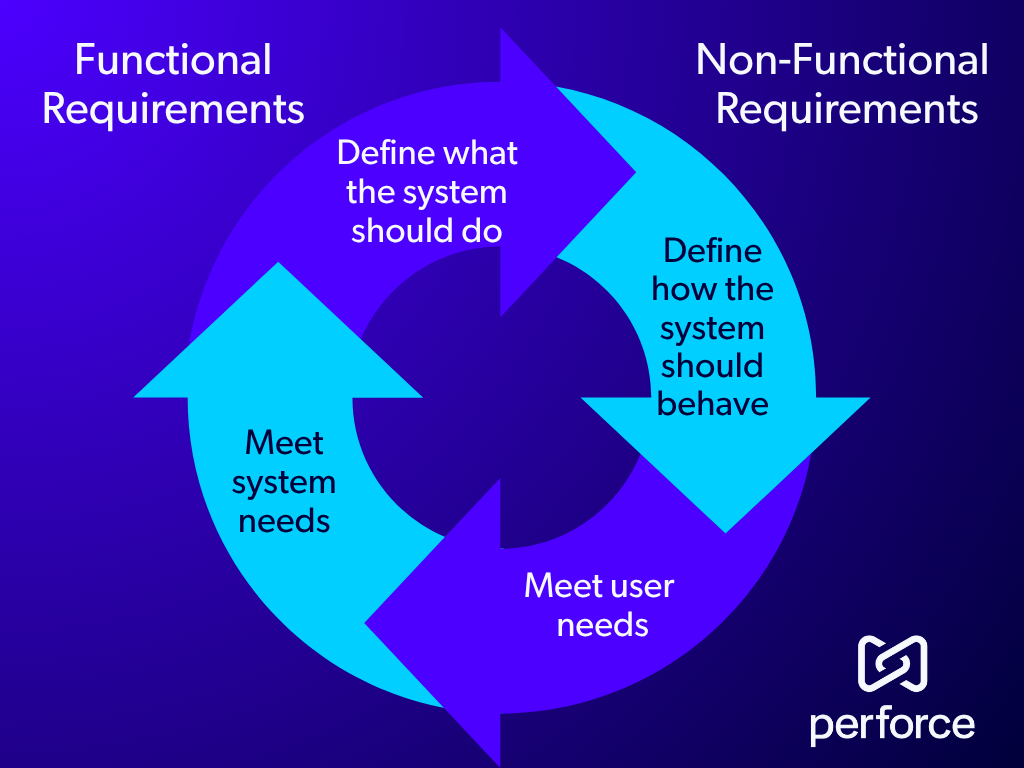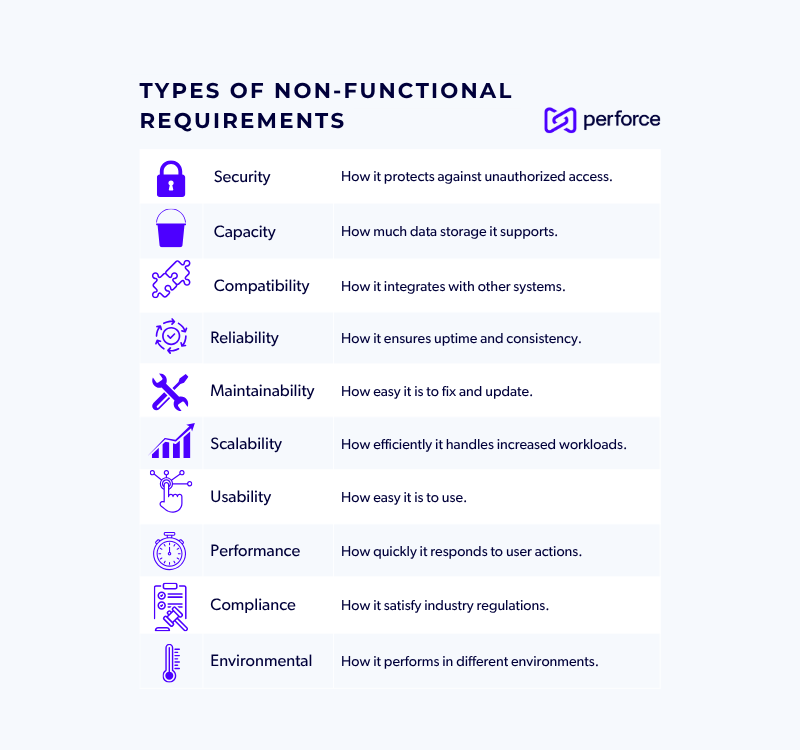Blog
June 4, 2025
Non-Functional Requirements: Tips, Tools, and Examples
Application Lifecycle Management
Developing high-quality products means carefully defining and tracking both functional and non-functional requirements (NFRs). But what exactly are non-functional requirements and how can you best manage them?
This guide will help you understand the difference between functional and non-functional requirements with real-world examples. It also covers best practices for writing them and discusses how to track and manage non-functional requirements for greater efficiency.
Table of Contents
- What Are Non-Functional Requirements?
- Development Checklist: 10 Types of Non-Functional Requirements
- Non-Functional Requirements Examples
- Future-Proofing and Continuous Improvement
- 15 Best Practices for Defining Non-Functional Requirements
- How Industries Leverage NFRs
- The Challenge: How to Manage Non-Functional Requirements
- Use Perforce ALM to Manage All Types of Requirements
Back to top
What Are Non-Functional Requirements?
Non-functional requirements specify criteria that evaluate how a system performs a function, rather than the function itself. Where functional requirements describe specific system functions, non-functional requirements define aspects like performance, security, usability, reliability, and scalability.
Another way to explain this is that functional requirements define the functionalities a system should have, while non-functional requirements define the characteristics. It’s important to note that a system can still work if non-functional requirements are not met, but it may not meet user and stakeholder expectations, or the needs of the business.
| Functional Requirement | Non-Functional Requirement | |
| Focus | What the system does | How the system behaves |
| Example | "User can reset password" | "System must reset password within 3 seconds" |
| Testable | Through functional testing | Through performance/security testing |
Attributes that make a product affordable, easy to use, and accessible come from non-functional requirements. As in the example above, they often act as constraints or quality goals for functional requirements. By defining performance as a non-functional requirement, you're essentially setting a limit on how complex certain functional features can be to ensure the overall system meets the desired performance standards.

Why Non-Functional Requirements are Important
While functional requirements (what the system does) often take the spotlight in backlog prioritization, non-functional requirements (how well the system does it) are increasingly recognized as equally important. Ignoring NFRs can lead to:
- Systems that crash under high loads
- Poor user satisfaction due to slow performance
- Security vulnerabilities
- Maintenance challenges over time
Development Checklist: 10 Types of Non-Functional Requirements
Having a list of NFR types defined up front, including key questions and corresponding solutions, provides a handy checklist to help you write clear requirements and ensure you don’t overlook critical concerns. Below are ten types of non-functional requirements every development team should consider:
1. Security
- Questions: Does your product store or transmit sensitive information? Does your IT department require adherence to specific standards? What security best practices are used in your industry?
- Solutions: Create requirements that address data protection, threat resistance, security protocols, and encryption.
2. Capacity
- Questions: What are your system’s storage requirements, today and in the future? How will your system scale to meet increased volume demands?
- Solutions: Requirements that outline memory and processing power.
3. Compatibility
- Questions: What are the minimum hardware requirements? What operating systems and their versions must be supported?
- Solutions: Clearly outline what type of hardware and operating system users will need to use your product. Consider how updates might impact function.
4. Reliability and Availability
- Questions: What is the critical failure time under normal usage? Does a user need access to this every hour of every day?
- Solutions: Establish your availability and fault tolerance so that the system consistently performs as intended over time.
5. Maintainability and Manageability
- Questions: How much time does it take to fix components, and how easily can an administrator manage the system?
- Solutions: Determine how easily the system should be updated or fixed with patches and improvements.
6. Scalability
- Questions: The Black Friday test: What are the highest workloads under which the system will still perform as expected?
- Solutions: Set guidelines for system growth and adaptation so that it handles increased usage without performance degradation.
7. Usability
- Questions: How easy is it to use the product? What defines the experience of using the product?
- Solutions: Determine criteria for a user interface that is easy to use and accessible to a wide audience.
8. Performance
- Questions: How quickly does the system respond to users’ actions, or how long does a user wait for a specific operation to happen?
- Solutions: Carefully define parameters around speed, response time, and resource usage so that performance aligns with user needs.
9. Compliance
- Questions: Are there specific requirements you need to satisfy for compliance in your industry? How likely will future regulations affect your product?
- Solutions: Research and address legal or regulatory standards to ensure the system adheres to current and future industry regulations and standards.
10. Environmental
- Questions: What types of environments will the system be expected to perform within?
- Solutions: Study how various physical environments might impact of system performance and set guidelines around temperature, humidity, vibration, etc.

Back to topNeed help writing great requirements?
Learn 9 tips.
Non-Functional Requirements Examples
Now that you understand the types of NFRs, let’s review what some real-world examples might look like:
| Type of Non-functional Requirement | Example |
| Performance | A stock trading app must execute trades in milliseconds to compete in the financial market. |
| Reliability | An airline’s booking system must be continually accessible to avoid disruptions to customers. |
| Usability (Accessibility) | An educational app for children should feature intuitive navigation, large buttons, and visual aids. |
| Security | A mobile banking app must use encryption protocols to safeguard user information. |
| Maintainability | A SaaS product should allow for seamless updates without disrupting end-users. |
| Scalability | A video streaming platform like Netflix must scale effortlessly to serve millions of simultaneous viewers during peak hours. |
| Compliance | A healthcare application must comply with HIPAA regulations to handle patient data securely. |
Each of these adds more specific restrictions or instructions to their corresponding functional requirements. Where the functional requirement defines the “what,” it often needs a non-functional requirement to define the “how.”
Learn essential tactics for better requirements management, from discovery to review and testing.
Back to top
Future-Proofing and Continuous Improvement
In addition to carefully curating their requirement backlog, teams must look ahead to shifting trends and technologies. Future-proofing software requires a proactive approach to NFRs that anticipates technological shifts and evolving user expectations. An Agile approach with continuous improvement ensures that systems remain robust, secure, and relevant over time.
Future-proof strategies include:
- Iterative Review: Regularly revisit NFRs throughout the product/software lifecycle to address new threats, technologies, and regulations.
- Automated Monitoring: Leverage management tools to monitor system performance, security, and compliance in real time.
- Modular Architecture: Design systems with modularity and extensibility in mind, enabling rapid adaptation to change.
- Stakeholder Engagement: Foster ongoing collaboration among developers, security experts, compliance officers, and sustainability leads to ensure NFRs remain aligned with organizational goals.
15 Best Practices for Defining Non-Functional Requirements
Our blog on functional requirements outlines tips on how to write requirements that apply to both functional and non-functional requirements. Some best practices include:
- Remain Cohesive: Be consistent, both in terminology and format.
- Set Measurable and Testable Criteria: Always define NFRs in quantifiable terms. For example, instead of saying "the system should be fast," specify "the system should respond to user input within 2 seconds." This ensures requirements can be objectively tested and validated
- Recycle: If you intend to reuse a requirement, write it in general enough terms to allow it to be reused. For example, use “accept payment” rather than “accept payment through Apple Pay."
- Integrate Early: Define NFRs alongside functional requirements at the outset of projects.
- Collaborate Cross-Functionally: Involve stakeholders from security, compliance, operations, and sustainability teams in NFR definition and validation.
- Align with Business Goals: Ensure NFRs align with customer expectations and product priorities.
- Automate Testing and Monitoring: Implement automated tools to continuously test and monitor NFRs for issues such as performance, security, and energy consumption. Identify and resolve issues early in the development cycle.
- Test in Production-like Environments: Ensure your testing environments closely mirror production in terms of data volume, network configuration, and infrastructure. This increases the reliability of test results and reduces deployment risks
- Build In Traceability: Maintain clear traceability between NFRs, design decisions, and test cases to ensure accountability and facilitate audits.
- Get Continuous Feedback: Use telemetry and user feedback to iteratively refine NFRs, ensuring systems meet real-world needs.
- Include Documentation and Training: Clearly document NFRs and provide training to ensure all team members understand their importance and implementation.
- Categorize and Prioritize Requirements: Group NFRs by categories (performance, security, usability, etc.) and prioritize them based on business goals, user needs, and technical constraints.
- Benchmark Against Industry Standards: Compare your NFRs with similar products or industry standards to identify gaps and set realistic, competitive targets.
- Integrate NFRs into the Definition of Done: Make passing non-functional tests a requirement for completing work, not an optional extra. This embeds quality into the development process and reduces the risk of last-minute surprises.
- Balance Trade-offs Transparently: Recognize that some NFRs may conflict (e.g., security vs. usability). Make trade-off decisions transparently, documenting the rationale and involving relevant stakeholders in the process.
By adopting these best practices, your organization ensures that your software not only meets current expectations but is also equipped to thrive in rapidly changing technological and regulatory environments. Additionally, you’ll minimize requirements churn that negatively impacts cost, quality, and your team's ability to meet deadlines.
📘Get the Guide: 5 Best Practices for Reducing Requirements Churn
Back to topHow Industries Leverage NFRs
All industries rely on carefully defined non-functional requirements to ensure their products meet consumer demands. Here are a few examples:
Healthcare
- Priorities: Security, reliability, and regulatory compliance
- Example: Electronic health record (EHR) systems must securely encrypt sensitive patient data to comply with HIPAA while providing medical staff with sufficient access.
E-Commerce
- Priorities: Performance, security, and usability
- Example: A sales app needs fast load times, secure payment processing, and easy user navigation to prevent lost sales.
Finance
- Priorities: Reliability and performance
- Example: Investment platforms must process large volumes of transactions quickly while ensuring data security.
Gaming
- Priorities: Performance, scalability, and reliability
- Example: Online multiplayer games must scale during peak times, and provide cross-platform compatibility to provide an engaging user experience.
Automotive and Embedded Systems
- Priorities: Compliance, reliability, environmental, and performance
- Example: In-vehicle system must respond within 100ms and operate between -40° to 185°.
Telecommunications
- Priorities: Compliance, reliability, maintainability, scalability
- Example: Ensure 99.999% network uptime with zero-downtime software patches.
Back to top
The Challenge: How to Manage Non-Functional Requirements
Many smaller organizations start by tracking requirements in text documents and spreadsheets, since this software is readily available and easy to navigate.
However, tracking requirements with spreadsheets and docs doesn’t support increasingly complex product development. These methods are time-consuming to maintain, lack traceability, and are susceptible to human error— putting you at serious risk of delays or even non-compliance.
At a certain point, you need a dedicated requirements management tool.
If your team is exploring requirements management solutions for traceability & compliance, check out our Requirements Management Software Buyer’s Guide. >>
Back to topUse Perforce ALM to Manage All Types of Requirements
Perforce ALM (formerly Helix ALM) offers development teams a unified requirements and test management platform. You get a comprehensive and intuitive requirements management tool that provides end-to-end traceability across the entire product development lifecycle. Perforce ALM scales to support the most complex projects and allows you to link functional and non-functional requirements to test cases, source code, and more for complete visibility of product quality.
Because it’s a modular tool, teams can start with the requirements management tool and then add on test case and issue management if needed.
Watch a free demo to see how Perforce ALM streamlines and simplifies requirements management with:
- Automatic, end-to-end traceability.
- Easy-to-configure workflows — even for dynamic, multi-level needs.
- Test case management that is automatically traced back to requirements.
- Built-in risk tracking accommodations for FMEA, ASIL, Hazard Analysis, and others.
- ISO 26262 compliance

